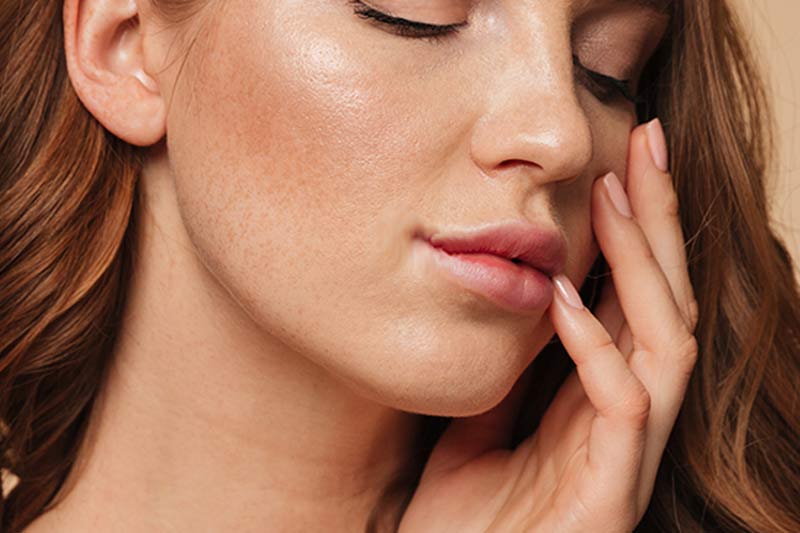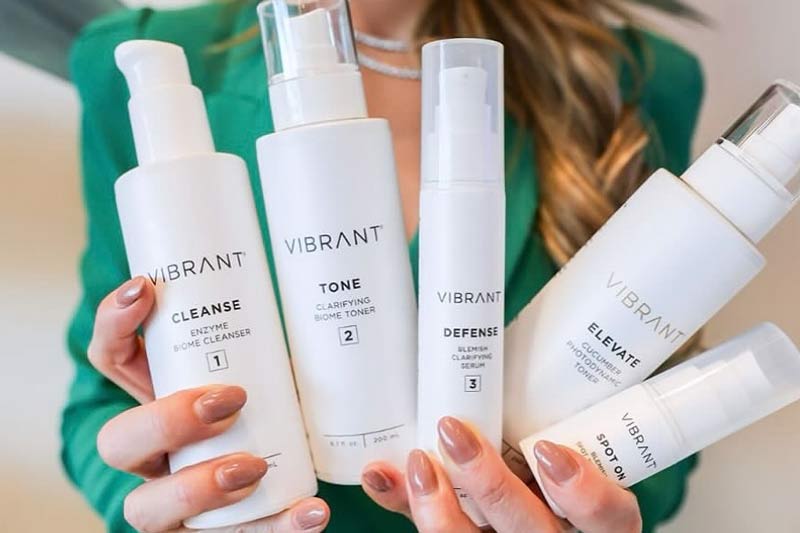Smooth, even skin is one of the clearest signs of health and vitality. While we often focus on breakouts, wrinkles, or dark spots, skin texture plays a major role in how youthful and fresh the face appears. Environmental stress, aging, and inconsistent care can all disrupt this delicate structure, leading to roughness or dullness.
This article explains skin texture, what causes textural skin concerns, and how to resolve them with adequate skin care.

What Is Skin Texture?
Skin texture refers to how the surface of the skin looks and feels to the touch. Ideally, it appears smooth, even, and supple, reflecting balanced hydration and healthy cell turnover. When the texture is rough, bumpy, or dull, it often indicates issues such as dryness, dead cell buildup, enlarged pores, or loss of elasticity.
Factors like genetics, aging, sun exposure, and environmental damage all influence skin texture over time. Because texture affects how light interacts with the skin, it plays a key role in how fresh, radiant, or tired the complexion appears. Popular trends like glass and mirror skin promote a smooth, reflective look, emphasizing the importance of skin texture.
What Determines Skin Texture?
Various factors affect the quality, texture, and appearance of our skin. They include:
- Genetics – People with family members who have problems with skin texture (e.g., acne) are more likely to have textured skin.
- Environmental factors – Dry air, humidity, pollutants, and other environmental aggressors can dehydrate the skin, disrupt sebum production, and cause different types of textured skin.
- Lifestyle – Smoking, drinking alcohol, lack of sleep, excess sugar intake, and other poor lifestyle habits significantly affect skin texture, increasing the risk of acne, enlarged pores, wrinkles, and other concerns.
- Sun exposure – UV radiation is the leading contributor to premature skin aging, causing fine lines and wrinkles, hyperpigmentation, and dry, textured skin.
- Hormonal status – A disbalance of hormones, such as estrogen, testosterone, insulin, and cortisol, often causes skin conditions like acne, enlarged pores, inflamed and itchy skin, skin tags, wrinkles, and more.
- Skin conditions – Eczema, rosacea, and other inflammatory skin conditions cause redness, rough skin, flakiness, and other irregularities that affect skin texture.
Common Causes of Textured Skin
Genetic, environmental, hormonal, and lifestyle factors can contribute to the following common causes of textured skin:
- Slower cell turnover and a buildup of dead skin cells
- Increased sebum production
- Dehydration
- Compromised skin barrier
- Collagen and elastin decline
- Acne scarring
Where on the Body Can Textured Skin Appear?
Textured skin can appear anywhere on the face and body, though it is most noticeable on the face. Other areas that are more prone to rough, flaky, or bumpy texture include:
- Neck
- Hands
- Arms
- Elbows
- Back
- Legs
- Knees
- Heels
These areas are commonly affected due to the buildup of dead skin cells, friction, and dryness.
Skin Texture Types
Experts distinguish several skin texture types:
- Rough – The skin appears rough due to the accumulation of dead skin cells, acne breakouts, acne scars, moisture loss, sun damage, friction, etc.
- Acneic –Acne-prone skin is characterized by frequent breakouts and raised, often inflamed bumps. In many cases, they lead to acne scars that manifest as bumps or indentations.
- Flaky – Loss of moisture and dehydrated skin disrupts the skin barrier and leads to flaky, peeling, red, and itchy skin patches.
- Wrinkled – Fine lines and wrinkles are common signs of aging and sun damage that affect texture.
- Bumpy – Some people experience tiny bumps on or under the skin’s surface. The bumps are usually small acne, clogged pores, or keratosis pilaris – a condition caused by keratin buildup that clogs hair follicles.
- Enlarged pores – Oily skin types suffer from sebum overproduction, which can clog pores and make them appear larger and more noticeable.
- Smooth – Normal skin doesn’t have any blemishes, bumps, or irregularities. It is smooth, even, and soft to the touch.
How to Improve Skin Texture
The right way to improve skin texture depends on the specific concern and its severity. In some cases, a consistent, daily skincare routine is enough to solve the problem. A combination of skincare products and cosmetic treatments usually provides the best results.
Skin Care

In most cases, a lack of moisture and the accumulation of dead cells and impurities are the direct cause of uneven skin texture. A gentle and consistent skincare routine focusing on hydration and exfoliation can help.
Cleansing
Gentle cleansers with soothing botanicals and hydrating agents (e.g., glycerin and hyaluronic acid) remove impurities from the skin’s surface without stripping it of essential oils. They help prepare the skin for active ingredients in the subsequent products.
Exfoliating
Exfoliating products are formulated with exfoliating agents, such as plant enzymes and alpha-hydroxy and beta-hydroxy acids. They are designed to dissolve the skin’s uppermost layer and remove impurities that clog the pores. Cosmetic professionals recommend using exfoliating products 1-3 times weekly to avoid drying out the skin.
Vitamin C and A
Serums containing potent antioxidants, such as vitamins C and A, help repair sun-damaged skin, strengthen the skin barrier, and improve skin tone and texture.
Vitamin C supports collagen and elastin production, reducing the appearance of fine lines and wrinkles. Vitamin A, often used in skin care as retinol, increases cell turnover, promotes cell regeneration, and minimizes the textural signs of aging (wrinkles, acne, etc.).
Moisturizing
Moisturizing is an essential step in skin care, especially when the skin barrier and texture are compromised. Use a rich moisturizer with hydrating agents, such as glycerin, hyaluronic acid, beta-glucan, and ceramides, to prevent moisture loss and help strengthen the skin barrier.
Sunscreen
A broad-spectrum sunscreen with SPF 30+ is the final step in the morning skincare routine. It protects the skin from harmful UV rays, preventing sun damage and helping maintain the benefits of previously applied products.
Note: Vibrant is an innovative skincare line designed to strengthen, repair, and protect the skin by balancing the microbiome, supporting the gut-brain-skin axis, and strengthening the skin’s innate regeneration capabilities. Check out Vibrant skin care for a complete daily routine.
Cosmetic Treatments
Non-invasive cosmetic treatments are a game-changer when it comes to promoting and maintaining healthy, resilient, and naturally glowing skin. The following are some of the most popular treatments for an even tone and smooth texture.
Chemical Peels
Chemical peels use chemical solutions of varying strengths and concentrations to remove the skin’s surface layer, along with all the impurities. The treatment increases cell turnover, refreshes and regenerates the skin, and promotes collagen production. It improves various textural concerns over time, including wrinkles, acne, and acne scars.
Microneedling
Microneedling helps address similar textural concerns as chemical peels but uses a different technology. A device with tiny needles creates controlled micro-injuries on the skin’s surface, stimulating the body’s natural healing mechanism and increasing collagen and elastin production. As these structural proteins rebuild, the skin’s texture becomes smoother and firmer.
Laser Resurfacing
A laser device sends light energy into the skin’s deeper layers, heating the dermis and stimulating more collagen and elastin production. The treatment remodels the skin, minimizing wrinkles and acne and promoting a smoother and tighter complexion.
Sofwave
Sofwave is the latest generation of non-invasive treatments, focusing on eliminating aging signs with minimal side effects and downtime. It uses ultrasound energy to boost collagen and elastin production in the mid-dermis, delivering impressive results after just one treatment.
Preventing Future Skin Texture Issues
We can’t stop time and enjoy smooth, blemish-free skin forever. However, certain skincare products and everyday behaviors can help us avoid dehydration and reduce the risk of textured skin. Use the following checklist to maintain a healthy, youthful complexion for as long as you can.
- Apply suitable skincare products for your skin type and textural concern every morning and evening.
- Exfoliate a few times per week.
- Apply sunscreen every day, regardless of the season.
- Avoid nicotine and alcohol.
- Limit or eliminate sugars and processed foods.
- Sleep seven to nine hours every night and go to bed before 10 p.m.
- Engage in stress-relieving activities to reduce cortisol.
- Schedule occasional collagen-boosting treatments.
When to Contact a Professional
Textured skin is usually not a medical but an aesthetic concern. However, you should seek the help of a medical professional if the symptoms of your skin problem are severe, disrupt your daily life, and lower your self-esteem. Visit an expert if you suffer from the following:
- Painful, pus-filled acne
- Frequent breakouts
- Severe acne scars
- Discomfort from dry skin
- Bleeding
Also contact a skin expert if you just need help choosing adequate skin care.
Conclusion
Everyone’s skin is different and characterized by a unique texture. Rough skin, acne scars, and wrinkles are something many people want to get rid of. Thankfully, the cosmetics industry offers advanced solutions that deliver results in a relatively short period.
If you are not sure what products to use, contact our Vibrant Skin professionals. They will create a customized skincare strategy for your textured skin and help you achieve your beauty goals.


